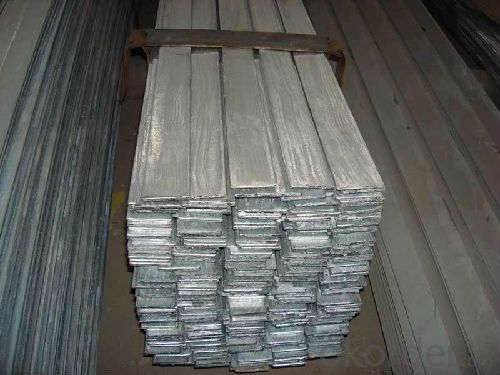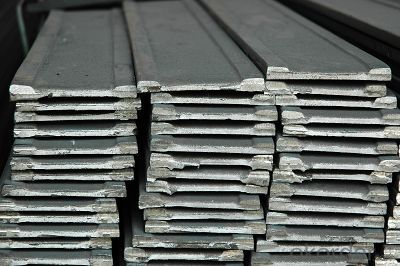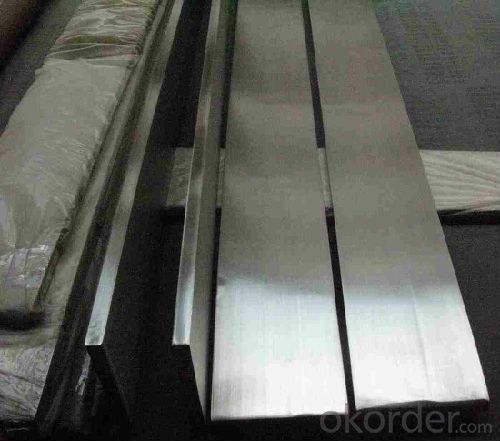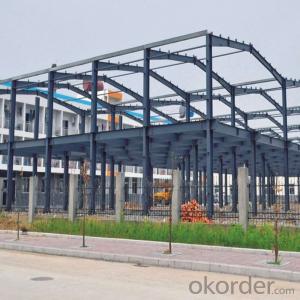11.08KG/M Steel flat bar for construction
- Loading Port:
- Tianjin
- Payment Terms:
- TT or LC
- Min Order Qty:
- 10000 m.t.
- Supply Capability:
- 10000 m.t./month
OKorder Service Pledge
OKorder Financial Service
You Might Also Like
Product Description:
OKorder is offering 11.08KG/M Steel flat bar for construction at great prices with worldwide shipping. Our supplier is a world-class manufacturer of steel, with our products utilized the world over. OKorder annually supplies products to European, North American and Asian markets. We provide quotations within 24 hours of receiving an inquiry and guarantee competitive prices.
Product Applications:
11.08KG/M Steel flat bar for construction are ideal for structural applications and are widely used in the construction of buildings and bridges, and the manufacturing, petrochemical, and transportation industries.
Product Advantages:
OKorder's 11.08KG/M Steel flat bar for construction are durable, strong, and resist corrosion.
Main Product Features:
· Premium quality
· Prompt delivery & seaworthy packing (30 days after receiving deposit)
· Corrosion resistance
· Can be recycled and reused
· Mill test certification
· Professional Service
· Competitive pricing
Product Specifications:
Specifications
1) . Easy to install, fire proof, good insulation
2). Certification: ISO9001:2000, SGS Standard.
Steel Structure Warehouse:
1.The steel structure of the connection method: welding connection
2.Steel structure design common norms are as follows: "Steel Design Code" (GB50017-2003) Cold-formed steel structure technical specifications" (GB50018-2002) "Construction Quality Acceptance of Steel" (GB50205-2001) "Technical Specification for welded steel structure" (JGJ81-2002, J218-2002) "Technical Specification for Steel Structures of Tall Buildings" (JGJ99-98)
3.The characteristics of steel Light weight steel structure Higher reliability of steel work Steel anti-vibration (earthquake), impact and good Steel structure for a higher degree of industrialization Steel can be assembled quickly and accurately Large steel interior space Likely to cause sealing structure Steel corrosive Poor fire-resistant steel Recyclable steel shorter duration
4.Commonly used steel grades and performance of steel Carbon
structural steel: Q195, Q215, Q235, Q255, Q275, etc.
High-strength low-alloy structural steel Quality carbon structural steel and alloy structural steel Special purpose steel Product Feature Carport, House, Office, Shop, Toilet, Villa, Warehouse, Workshop, Plant Other Information
Products have been all over the country more than 20 provinces, municipalities and autonomous regions, and have been exported to Europe, North America, the Middle East, Africa, Asia and other countries and regions, the widespread use
Welcome to our factory, we assure that our products will satisfy your needs with designs, competitive performance price ratio and best services.
FAQ:
Q1: Why buy Materials & Equipment from OKorder.com?
A1: All products offered byOKorder.com are carefully selected from China's most reliable manufacturing enterprises. Through its ISO certifications, OKorder.com adheres to the highest standards and a commitment to supply chain safety and customer satisfaction.
Q2: How do we guarantee the quality of our products?
A2: We have established an advanced quality management system which conducts strict quality tests at every step, from raw materials to the final product. At the same time, we provide extensive follow-up service assurances as required.



- Q:How are steel structures used in electrical and lighting systems?
- Steel structures are commonly used in electrical and lighting systems for their strength, durability, and versatility. These structures provide support and stability to various components and fixtures, ensuring the proper functioning and safety of the system. In electrical systems, steel structures are often used to support power transmission lines and distribution networks. They are utilized to mount transformers, circuit breakers, switchgears, and other equipment that facilitate the flow of electricity. Steel towers and poles are specifically designed to withstand the weight and tension of power lines, ensuring a reliable and efficient electrical supply. In lighting systems, steel structures play a crucial role in providing a stable foundation for streetlights, floodlights, and other outdoor lighting fixtures. They are used to mount these fixtures at the optimal height and angle to achieve the desired illumination. Steel poles and brackets are also commonly used for mounting indoor lighting fixtures, such as in commercial and industrial buildings. Steel structures offer several advantages in electrical and lighting systems. They are highly durable and resistant to environmental factors such as wind, rain, and corrosion. This ensures the longevity and reliability of the system, minimizing maintenance and replacement costs. Moreover, steel structures can be easily customized and fabricated to meet specific design requirements, allowing for flexibility and adaptability in different applications. Overall, steel structures are integral components in electrical and lighting systems, providing the necessary support, stability, and durability for the safe and efficient operation of these systems.
- Q:How are steel structures designed to provide adequate access and egress?
- Adequate access and egress in steel structures are achieved through various methods. Initially, the placement and size of doors and windows are taken into account during the design process. These openings are strategically positioned to allow smooth and efficient movement in and out of the structure. Moreover, the design incorporates stairs and ramps to facilitate safe and accessible transitions between different levels of the building. These elements are carefully designed with appropriate dimensions, handrails, and non-slip surfaces to ensure the safety of users. Additionally, elevators and lifts can be installed in steel structures to enhance accessibility for individuals with limited mobility. These vertical transportation systems adhere to relevant accessibility standards and regulations, ensuring that everyone can easily navigate the building. Furthermore, the design also considers the placement of emergency exits and evacuation routes. These exits are strategically located and designed to provide clear and unobstructed pathways to safety during emergencies. Overall, the design of steel structures prioritizes the provision of adequate access and egress by meticulously planning the placement and design of doors, windows, stairs, ramps, elevators, and emergency exits. This guarantees efficient and safe movement for individuals entering and exiting the structure.
- Q:How are steel structures used in the construction of supermarkets?
- Steel structures are commonly used in the construction of supermarkets due to their numerous advantages. Firstly, steel is a strong and durable material, making it ideal for supporting the large spans and heavy loads that supermarkets require. It can withstand high winds, earthquakes, and other natural forces, ensuring the safety of the building and its occupants. Moreover, steel structures offer flexibility in design and construction. Supermarkets often need large open spaces to accommodate a variety of products, shelving, and aisles. Steel beams and columns can be easily customized and fabricated to create these open floor plans, allowing for maximum utilization of space. Additionally, steel structures offer speed and efficiency in construction. Prefabricated steel components can be manufactured off-site and then quickly assembled on-site, reducing construction time and costs. This is particularly advantageous for supermarkets, as they often have tight project schedules and need to open their doors to customers as soon as possible. Another benefit of steel structures is their versatility. They can be easily modified or expanded in the future, allowing supermarkets to adapt to changing needs or market trends. This flexibility is crucial in the retail industry, where store layouts and product displays may need to be altered to meet evolving customer preferences. Lastly, steel structures are environmentally friendly. Steel is a recyclable material, and many steel components used in construction are made from recycled steel. This helps reduce the demand for new raw materials and minimizes waste. Additionally, steel structures can be designed to be energy-efficient, incorporating insulation and efficient HVAC systems to reduce energy consumption and operating costs. In conclusion, steel structures are widely used in the construction of supermarkets due to their strength, flexibility, speed of construction, versatility, and environmental sustainability. They provide the necessary support and space for supermarkets to operate efficiently and effectively, ensuring a safe and comfortable shopping experience for customers.
- Q:What is the main component in the steel structure and what is the secondary component?
- Component: embedded parts, roof purlin, wall purlin, knee brace, brace, tie bar, bar, gutter, edge etc.
- Q:What are the considerations when designing steel structures for cleanrooms and laboratories?
- When designing steel structures for cleanrooms and laboratories, several key considerations must be taken into account. Firstly, the materials used for the steel structure should be corrosion-resistant, as the environment within cleanrooms and laboratories often involves exposure to chemicals and moisture. Additionally, the design should incorporate proper ventilation systems to ensure the removal of contaminants and maintain the desired air quality. The structure should also prioritize ease of cleaning and maintenance, with smooth surfaces and minimal crevices where dirt or particles can accumulate. Lastly, the design must comply with stringent safety regulations and standards to ensure the protection of personnel and the integrity of the facility.
- Q:How are steel structures designed to accommodate vertical transportation systems?
- Steel structures are designed to accommodate vertical transportation systems by incorporating features such as elevator shafts, stairwells, and sufficient load-bearing capabilities to support the weight and movement of elevators and escalators. The design ensures that the steel framework provides a stable and secure foundation for the transportation systems, allowing for efficient and safe vertical movement within the structure.
- Q:What are the steps involved in the construction of a steel structure?
- The steps involved in the construction of a steel structure typically include site preparation, foundation design and construction, steel fabrication, erection, and finishing works. Site preparation involves clearing the area, leveling the ground, and ensuring proper drainage. Foundation design and construction involve determining the type of foundation required, such as shallow or deep foundations, and then constructing it accordingly. Steel fabrication includes the manufacturing of steel components, such as beams, columns, and trusses, as per the project specifications. Erection involves the assembly and placement of these fabricated steel elements on the foundation, often with the use of cranes and other heavy equipment. Finally, finishing works like insulation, cladding, and interior fittings are done to complete the steel structure.
- Q:How are steel structures used in the construction of stadiums and arenas?
- Steel structures are extensively utilized in the construction of stadiums and arenas due to their numerous advantages. The framework or skeleton of the building is one primary application of steel in these structures. Steel offers exceptional strength and durability, enabling the creation of large open spaces and wide spans without the need for numerous supporting columns or walls. This results in unobstructed views for spectators and maximizes seating capacity. Moreover, steel structures can be conveniently fabricated off-site and then assembled on-site, leading to reduced construction time and costs. The prefabrication process ensures construction of high quality and precision, resulting in a safe and reliable structure. Steel also possesses excellent fire resistance properties, making it an ideal material for stadiums and arenas where safety is of paramount importance. Another advantage of steel structures in stadium construction lies in their flexibility and adaptability. Steel can be easily modified or expanded upon in case future renovations or additions are required. This proves particularly advantageous for stadiums and arenas that may need to accommodate changing needs such as increased seating capacity or the incorporation of new technologies. Furthermore, steel structures are environmentally friendly. Steel is a recyclable material, which means it can be reused or repurposed at the end of its lifespan. This practice reduces waste and contributes to sustainable construction practices. In conclusion, steel structures play a critical role in the construction of stadiums and arenas by providing strength, durability, flexibility, and sustainability.
- Q:How are steel structures inspected and maintained?
- To ensure the stability, durability, and safety of steel structures, a systematic process of inspection and maintenance is implemented. Throughout the lifespan of the structure, regular inspections are conducted at various stages, including during construction and after completion. The inspections primarily consist of visual examinations aimed at identifying signs of corrosion, cracking, or other damages. Following this, more detailed assessments are carried out, which may involve non-destructive testing techniques like ultrasonic testing, magnetic particle testing, or radiography. These methods help uncover any hidden defects or weaknesses in the steel components. The maintenance of steel structures is of utmost importance to prevent deterioration and ensure long-term performance. Routine activities such as cleaning, painting, and lubrication are performed to safeguard against corrosion. Additionally, the condition of structural elements is continuously monitored, and any identified issues are promptly addressed. Apart from regular maintenance, periodic structural assessments are conducted to evaluate the load-carrying capacity of steel structures. This is particularly crucial for structures exposed to heavy loads or harsh environmental conditions. Structural assessments typically encompass a combination of visual inspections, material testing, and computer simulations to analyze the behavior of the structure under different loads. In summary, a comprehensive approach is necessary for the inspection and maintenance of steel structures to identify and resolve potential issues. By implementing a proactive maintenance regimen, steel structures can be maintained in optimal condition, ensuring their safety and longevity.
- Q:How are steel structures designed for efficient transportation and logistics?
- Steel structures are designed for efficient transportation and logistics through careful planning and consideration of various factors. One key aspect is the use of modular and prefabricated components. By breaking down the structure into smaller modules, it becomes easier to transport and assemble them at the desired location. These modules are designed to fit together seamlessly, ensuring efficient transportation and logistics. Furthermore, steel structures are designed to be lightweight yet sturdy. This reduces the overall weight of the structure, thereby minimizing transportation costs. The use of advanced engineering techniques and materials helps in achieving this balance between strength and weight. In addition, steel structures are often designed with ease of assembly in mind. This means that they can be quickly and efficiently erected at the desired location. This is particularly important for transportation and logistics purposes, as it reduces the overall time required for construction and minimizes disruptions to the surrounding area. Moreover, steel structures can be designed to be easily disassembled and relocated if necessary. This flexibility is beneficial for transportation and logistics purposes, as it allows for the structure to be moved to a different location if the need arises. This is especially useful in industries where rapid deployment or frequent relocation of facilities is required. Lastly, steel structures can incorporate various features to enhance transportation and logistics efficiency. For example, they can be designed with integrated loading docks, ramps, and other specialized features to facilitate the movement of goods and materials. Additionally, the design can include provisions for the installation of overhead cranes or other lifting equipment, enabling efficient handling and storage of heavy items. Overall, steel structures are meticulously designed to ensure efficient transportation and logistics. From modular components and lightweight materials to ease of assembly and disassembly, these structures are carefully crafted to minimize costs and time associated with transportation, while maximizing flexibility and functionality.
1. Manufacturer Overview |
|
|---|---|
| Location | |
| Year Established | |
| Annual Output Value | |
| Main Markets | |
| Company Certifications | |
2. Manufacturer Certificates |
|
|---|---|
| a) Certification Name | |
| Range | |
| Reference | |
| Validity Period | |
3. Manufacturer Capability |
|
|---|---|
| a)Trade Capacity | |
| Nearest Port | |
| Export Percentage | |
| No.of Employees in Trade Department | |
| Language Spoken: | |
| b)Factory Information | |
| Factory Size: | |
| No. of Production Lines | |
| Contract Manufacturing | |
| Product Price Range | |
Send your message to us
11.08KG/M Steel flat bar for construction
- Loading Port:
- Tianjin
- Payment Terms:
- TT or LC
- Min Order Qty:
- 10000 m.t.
- Supply Capability:
- 10000 m.t./month
OKorder Service Pledge
OKorder Financial Service
Similar products
New products
Hot products
Hot Searches
Related keywords






























